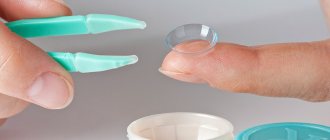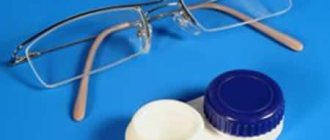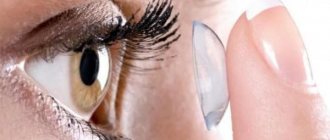What is service time?
This is the time during which a closed, unopened blister can be used. When it comes to contact vision correction, one should distinguish between the expiration date and the period of use. The latter will talk about the time you can wear the lenses after opening the container.
Where on the box does it say how long you can wear it?
Contact lenses are always double packed.
When purchasing, you receive a sealed cardboard box. It contains information about the manufacturer, the number of blisters inside and the expiration date of the package. Most often this is 4 years from the date of production. After unpacking, you can see blisters inside, each of which individually contains a solution with a contact lens. The blister is tightly sealed, which means its contents are absolutely sterile. On its lid it contains duplicate information about expiration dates in year/month format.
It should not differ from that indicated on the general cardboard package. Reference! The date on blisters with a foil lid must be reliably stamped, which eliminates the possibility of counterfeiting.
If there are only a few days left before the expiration date, and the lenses are planned to be used for a month, then you can safely wear such a product. The expiration date is based on the fact that the product should be opened before it expires, and can be worn for some more time, as recommended by the instructions.
What is the difference between storing in a closed package and in an already opened one?
After opening the lid of the blister, its sterility is violated. From this moment on, it is not the expiration date that is counted, but the operating time of the contact lens. The material from which they are made – hydrogel – is very thin. It is this delicate structure that allows our eyes not to feel discomfort when worn.
Opened contact lenses begin to accumulate everything that is in the environment, including:
- chemical aerosols;
- coarse protein deposits;
- bacteria and their spores.
Therefore, the period of wearing contact correction products is sharply limited in time.
Best before date
There are two terms - SG and service life, which have different meanings. Despite this, many perceive these 2 concepts as one. As for the first, it indicates the duration of storage of the contact correction in a closed package. The date can be seen on the lid of the blister itself, which indicates the year and month before which the product should be used. For example, “2019/01” means that until January 2020, CLs are suitable for storage. Eye health and comfortable wearing of lenses directly depends on SG. The service life is counted from the moment the cable cable is opened, regardless of when the product was purchased.
At the end of the period of use, the performance characteristics of the lenses deteriorate, which can lead to irritation of the eye mucosa. Even if no discomfort is initially felt, the visual apparatus may be at risk.
The materials of the CLs themselves also affect the storage duration. Hard lenses are polymer contact optics created on the basis of silicone. Silicone allows maintaining good gas permeability. Such optics do not expire, because they are delivered dry without the risk of breaking the seal of the packaging. Soft CLs require special storage in a special solution; they are made from silicone hydrogel and hydrogel polymers. The allotted storage time for such products is up to 4 years. However, expiration dates may vary between manufacturers.
Types of lenses and service life
Improper storage and use of optics will significantly reduce their service life.
As for the safe wearing time, it can expire faster if handled carelessly, not following the rules of sterile storage (relevant for reusable lenses), or contamination with cosmetics. There are the following types of CL:
- Traditional, designed for 6-9 months.
- Quarterly, intended for use up to 3 months.
- Scheduled replacement, replaced every month.
- Daily. They are considered the safest optical products.
- Frequent scheduled replacement, used within 1-2 weeks.
What is the wearing period for the eyes?
This is the period during which you can use an opened pair of contact lenses absolutely safely for your health. Exceeding the recommended periods will lead to eye complications:
- corneal edema;
- keratitis;
- conjunctivitis.
Important! If an eye infection develops, it is recommended to use only glasses during the entire treatment period.
What is it and how do you recognize it?
The wearing period is indicated by the manufacturer directly on the packaging. It is determined during long-term clinical studies, so it is not recommended to violate it. Depending on the time of wearing, contact vision correction devices are divided into:
- Traditional - scheduled replacement is necessary every 6-9 months. Such prolonged use leads to the need to use aggressive enzyme and peroxide solutions to clean the hydrogel from coarse protein and lipid deposits. These solutions often cause irritation and allergic reactions.
- Quarterly – require replacement every 3 months. They also require periodic enzyme cleaning every 1-2 weeks.
- Scheduled replacement - must be changed every two or four weeks of wear, depending on the specific type. Aggressive enzymatic cleaning is not necessary, since in such a short period of time, severe contamination does not form on the surface of the hydrogel. These are one of the most popular models due to the adequate combination of price and quality.
- Daily – enough for one day. These are the safest lenses with almost zero risk of complications. Every day a new sterile package is opened, so infection is unlikely. Plus, there's no need to use a solution, making daily lenses great for people with allergies. The only drawback is the high cost.
Does it make a difference if a pair has been used once or is used irregularly?
The wearing period of the lens is always counted after opening the package. From this moment on, the lens will no longer be sterile; it will begin to accumulate unnecessary substances and become dirty.
If the packaging indicates a recommended wearing time of 2 weeks, then after 14 days the lenses must be discarded, even if they were used only once. Only such careful adherence to wearing rules can preserve vision and avoid complications. Lenses with a long replacement period, for example, 3-9 months, can be stored in solution during this entire period and used occasionally. But every month the solution is changed to clean. This leads to confusion and possible discomfort when worn, so if contact correction is not used regularly, it is better to have daily lenses and throw them away after use.
Wearing mode and period of wearing contact lenses
Many contact lens wearers do not understand at all what “wearing mode” and “wearing period” are. These concepts are important and worth understanding so that contact lenses are selected correctly and do not cause discomfort and eye disease.
Contact lens wearing regimen
means the maximum period of time that lenses can be worn without removal.
According to the mode of wearing lenses, there are:
· DW – day mode (must be removed at night);
· FW – flexible mode (lenses can sometimes be left on for 1-2 nights);
· EW – prolonged (can be used continuously for up to 7 days, depending on the manufacturer’s recommendations);
· CW – long-term continuous (without taking off for up to 30 days).
Wearing period of contact lenses
means the maximum period of use of lenses, after which they must be replaced with new ones.
By wearing period:
· daily replacement (one-day, disposable);
· frequent scheduled replacement (every 1 – 2 weeks);
· planned replacement (after 1 – 3 months);
· traditional (after 6 months or more).
When purchasing contact lenses, pay attention to the wearing instructions and always remove contact lenses on time. When wearing lenses, their oxygen permeability, moisture content and other characteristics are of great importance. If the lenses are left on the eyes for longer than expected and if you sleep in the lenses unless permitted by the manufacturer, great harm can be caused to the eyes.
Carefully monitor the period of wearing contact lenses and always replace them with new ones on time. When calculating the replacement period for lenses, the manufacturer takes into account the resistance of their material to protein deposits and dirt. If you use lenses longer than the specified period, this can lead to diseases and inflammation of the eyes.
If you monitor the expiration date, mode and period of wearing contact lenses and always follow the rules for their use, then you will be ensured not only clear vision, but also eye comfort and safety for their health.
Why are there differences in the use of colored and regular ones?
Colored lenses do not differ radically from regular ones in terms of shelf life and wear. They can also be used for the entire period indicated on the package. As with regular lenses, it is most convenient to use daily lenses that do not require rough cleaning.
But due to the coloring pigment, it is not advisable to wear colored contact correction products all day long. They have a lower oxygen transmittance, and therefore impair the nutrition of the cornea of the eye.
Unlike clear lenses, colored lenses cannot be used around the clock; it is better to sharply limit the time they are worn.
Contact lenses have become a part of our lives. They are worn by both teenagers and older people. Modern materials make it possible to cause minimal harm to the eyes, but significantly improve visual acuity. It is only important to follow the rules of use recommended by experts.
What can happen?
Incorrect use of contact lenses provokes the development of vision pathologies such as keratitis.
The sterility and safety of lenses, their integrity and correct shape are maintained only within the expiration date indicated by the manufacturer on the packaging. Due to incorrect use, allergies may occur, the formation of protein deposits may be accelerated, and oxygen permeability may be reduced. Changes in the characteristics of optics, as well as acceleration of contamination processes, can provoke:
- conjunctivitis;
- keratitis;
- inflammation of the optic nerve;
- decreased oxygen permeability;
- chronic diseases.
If the rules for using such optics are systematically violated, the visual apparatus constantly suffers from allergies, which will become chronic. Discomfort, burning, dryness will indicate aversion to contact lenses. In this case, glasses will be the only option to improve vision. The period indicated by the manufacturer for use, as well as the general expiration date, give the consumer an accurate understanding of when to change lenses, even if wearing does not cause discomfort.
Why can't you wear contact lenses?
If you see on the packaging that the lenses can be worn for exactly 30 days, then this does not mean that the product can only last for this period. This is the time after which the manufacturer recommends replacement. That is why it is not recommended to overwear the products, even if you do not feel any discomfort.
Even when providing high-quality care, remember that the material may lose its properties. If you replace your old lenses, then you will probably notice that the quality of your vision has improved. When your lenses expire, you may feel more than just discomfort. Sometimes the consequences can be quite serious.
It is important to know! If the manufacturer indicated a date and you notice that it is expired, then before using such lenses they will need to be treated with appropriate products. If this is not done, then the use of the product is prohibited.
How to choose a lens solution
The selection of solution for contact lenses should be carried out by a specialist, because you should choose it taking into account all the characteristics of your body. But you can try to choose the liquid yourself (of course, taking responsibility for your own health).
- Evaluate the composition. Solutions from different manufacturers differ in composition, but the comfort and safety of wearing lenses largely depends on the presence of any substances in the liquid.
- Exclude from your range of choices those solutions that contain substances that can cause you allergies.
- Think about your lifestyle. Depending on how long you wear your lenses or how often you put them on, the choice of solution for storing and cleaning them will also depend.
- Try it. Just be careful. If after using the solution your eyes become red, itchy or dry, try choosing a different solution with the help of an ophthalmologist.
The selection of solution for contact lenses should be carried out by a specialist
How to understand how long the lenses are valid?
As a rule, each manufacturer first indicates on the packaging the year until which contact lenses can be worn, and then the month.
So, for example, if the package says 2022/09, this means that contact lenses can be used until September 2022. It is worth considering that the shelf life indicated on the package is maximum only if the optical products are stored in a buffer solution located inside the blister. We draw your attention to the fact that it does not matter what day you purchased contact correction products. Even if the lenses in their packaging expire the day after purchase, these optical products can still be worn. The fact is that after the specified time, the solution itself may deteriorate, but not the ophthalmic products. Much more important is the fact in which solution the lens is located. If it is expired, then it loses its disinfecting properties, which means that optical products begin to dry out and gradually lose their inherent properties.
The second concept that every user who chooses to wear lenses should know is the service life of optical products. During this time they can be used. It begins on the day you first put them on your eyes, and is in no way related to the period indicated on the closed package. The period of time during which correction products can be worn is indicated on the blister itself.











